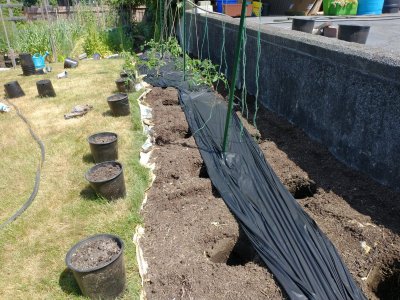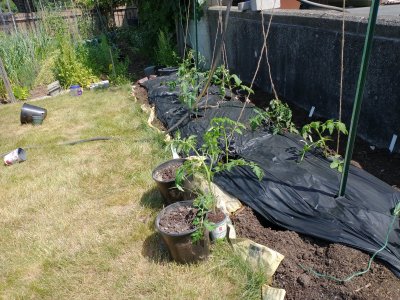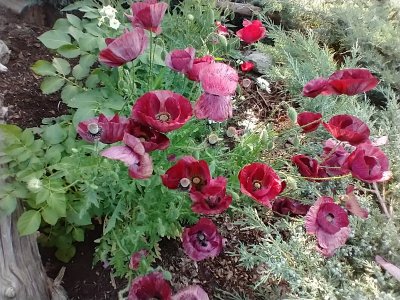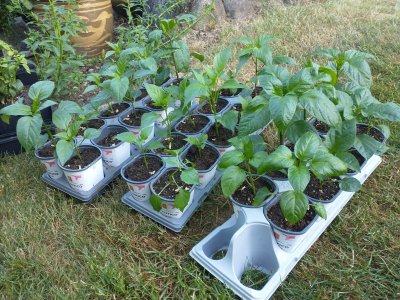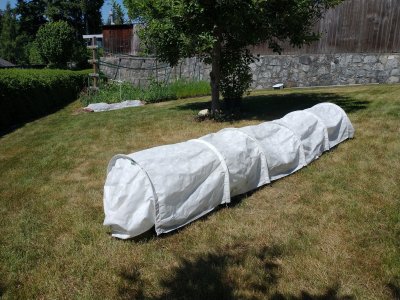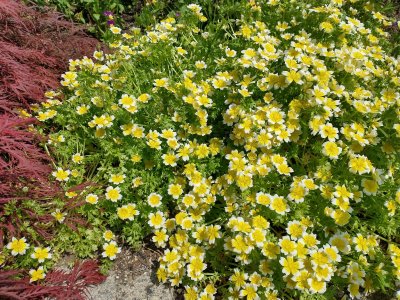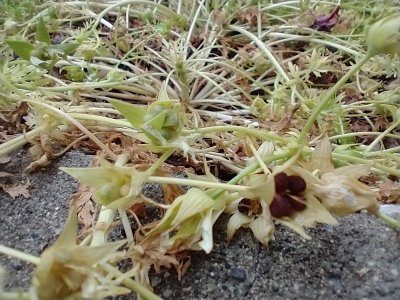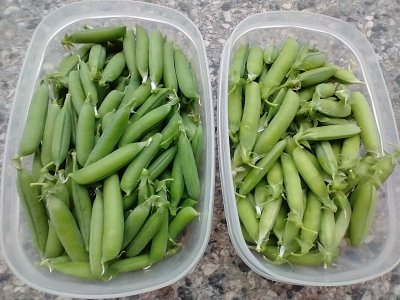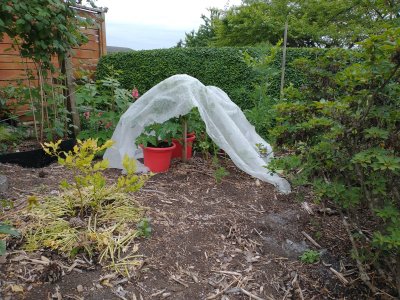- Thread starter
- #231
Branching Out
Garden Addicted
On May 6th I posted photos of the ground work for our new tomato patch. This week was the next step as we roughed in a 4' wide strip of Bio360 black film, as we had to have that in place when the posts and cattle panel went in. (As a side note, I left the black film loose on the top of the soil for several days, and was dismayed to see that the heat and sun had made it all stick together in a black wrinkly mess. Fortunately I was able to gently pull it fairly flat again, but I had to make a note to myself to not allow it to become bunched up ever again-- not even for one day). I also attached strong twine to the top of the cattle panel, to twine around the tomato stems as they grow.
A few days later favourable planting weather arrived, so I was able to move on to the fun part-- tomato planting day. I added a scoop of dry organic fertilizer to each of the twenty seven 2 gallon container 'place holders' for each planting hole, and mixed it in a bit. Then I lifted out all of the 2 gallon pots and watered each planting hole deeply 3 or 4 times; the holes were very well-defined after sitting for a month, so prepping the holes well in advance is a technique I will definitely use again. One by one I tore a hole in the Bio360 black film to correspond with the pre-dug hole in the ground, placed the end of the strong twine through the hole, sat a tomato plant on top of the string planting it as deep as I could, and dumped out the contents of one 2 gallon container to firmly back fill around the plant. The bottom of each bucket was absolutely full of red wigglers, so lots of good soil biology going in with the tomato seedlings. I watered one more time at the end as it was a very warm afternoon. Today we finally received an inch of rain after a month-long drought, so the plant roots will be starting out well-hydrated.
There are still a few more seedlings to go in, and then this newly created patch will be at full capacity. At that point I will make sure the Bio360 is tucked in and buried with compost around all of the edges, so it doesn't blow around when it gets windy. I will also sow some alyssum seeds here and there, and tuck in some cerinthe seedlings in order to attract beneficial insects to the patch. Cerinthe will be going in my squash patch too as from what I understand bees can really assist in pollinating squash, and Higgledy Garden says 'bees go wonky for the conk' for Cerinthe.
A few days later favourable planting weather arrived, so I was able to move on to the fun part-- tomato planting day. I added a scoop of dry organic fertilizer to each of the twenty seven 2 gallon container 'place holders' for each planting hole, and mixed it in a bit. Then I lifted out all of the 2 gallon pots and watered each planting hole deeply 3 or 4 times; the holes were very well-defined after sitting for a month, so prepping the holes well in advance is a technique I will definitely use again. One by one I tore a hole in the Bio360 black film to correspond with the pre-dug hole in the ground, placed the end of the strong twine through the hole, sat a tomato plant on top of the string planting it as deep as I could, and dumped out the contents of one 2 gallon container to firmly back fill around the plant. The bottom of each bucket was absolutely full of red wigglers, so lots of good soil biology going in with the tomato seedlings. I watered one more time at the end as it was a very warm afternoon. Today we finally received an inch of rain after a month-long drought, so the plant roots will be starting out well-hydrated.
There are still a few more seedlings to go in, and then this newly created patch will be at full capacity. At that point I will make sure the Bio360 is tucked in and buried with compost around all of the edges, so it doesn't blow around when it gets windy. I will also sow some alyssum seeds here and there, and tuck in some cerinthe seedlings in order to attract beneficial insects to the patch. Cerinthe will be going in my squash patch too as from what I understand bees can really assist in pollinating squash, and Higgledy Garden says 'bees go wonky for the conk' for Cerinthe.
Attachments
Last edited:

